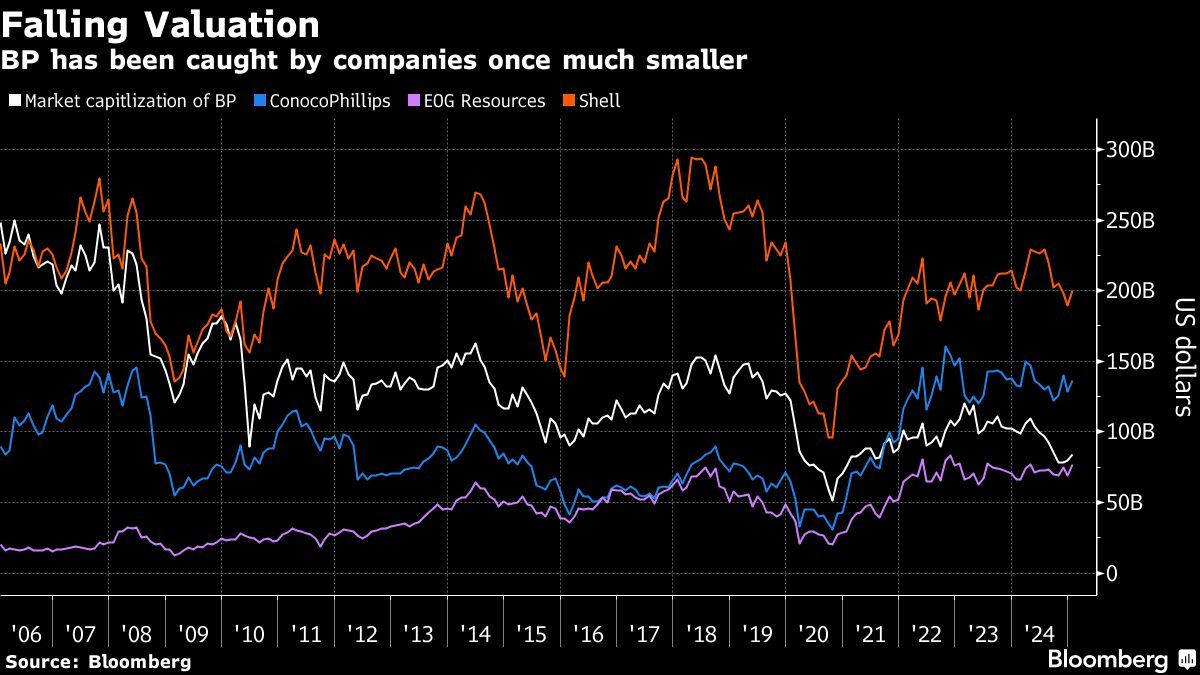
The expectation is that BP plc chief executive officer Murray Auchincloss will announce in February a further shift back towards oil and gas, yet there are many questions about whether this can be accomplished quickly enough.
(Jan 16): BP plc is eliminating 4,700 positions internally, about 5% of its workforce, and more than 3,000 contractor jobs, chief executive officer Murray Auchincloss told staff on Thursday, as the London-based energy giant seeks to reduce costs.
More cost-cutting efforts are planned this year and beyond, Auchincloss said, and the company has stopped or paused 30 projects since June last year to focus on the ones that make the most money. The company’s digitisation drive, including pushing artificial intelligence across departments, is key to these plans, Auchincloss said.
BP has fallen further behind its fellow oil majors during Auchincloss’s tenure as the CEO, and is now worth less than half as much as Shell plc. It is even being caught by companies that were once just a fraction of its value.
Faced with this performance, investors want to see change. The expectation is that Auchincloss will announce in February a further shift back towards oil and gas, yet there are many questions about whether this can be accomplished quickly enough.
The job cuts come days after BP announced it was delaying the February strategy update and relocated it to London from New York to give Auchincloss more time to recover from a medical procedure.
“I understand and recognise the uncertainty this brings for everyone whose job may be at risk, and also the effect it can have on colleagues and teams,” Auchincloss wrote in an email to BP employees, which was also provided to Bloomberg. “We have got more we need to do through this year, next year and beyond, but we are making strong progress as we position BP to grow as a simpler, more focused, higher-value company.”
BP shares had risen by 1.2% to 428.1 pence as of 11.47am in London on Thursday, outperforming most European energy peers of the Stoxx Europe 600 Energy Index.
BP’s fall in recent years reflects strategic miscalculations that extend far beyond Auchincloss’s single year as the permanent CEO. His predecessor Bernard Looney embraced low-carbon energy, made a faulty prediction that global oil consumption had already peaked and drove expensive forays into offshore wind — only to be fired for his personal conduct before the strategy could be realised.
BP has since been watering down Looney’s strategy incrementally. It slowed the planned reduction in its oil and gas output in February 2023, stopped or paused a series of clean hydrogen projects, and in December announced the spin-off of its entire offshore wind business.
But the company has resisted making the more forceful pivot back into fossil fuels that some investors have been demanding. It has repeatedly reassured shareholders that it has enough untapped resources to fulfill its production plans, yet since 2020 it has given the green light to just one major oil project, the Kaskida field in the Gulf of Mexico. This long period of upstream neglect will make it more difficult to achieve a quick turnaround, analysts say.
Uploaded by Tham Yek Lee
- Tariff shock awaits China after trade surplus hits US$103 bil
- Malaysian semiconductor stocks fall amid US probes, software firms steady
- Maybank customers can now make QR payments through MAE app in Cambodia
- HRD Corp's chief executive Shahul Hameed steps down, confirming The Edge report
- Nation gathers to bid farewell to Pak Lah
- S&P sees Apac credit conditions remaining firmly on the downside amid US-China trade tensions
- High Court doubles fine to RM10,000 for former UM student activist for insulting vice-chancellor
- South Korea aims to delay US tariffs in talks, cooperate in mutual areas
- Experts see retail sales growth slowing amid mounting costs
- Shares edge up on some tariff reprieve, US bonds steady

